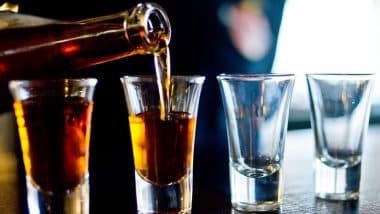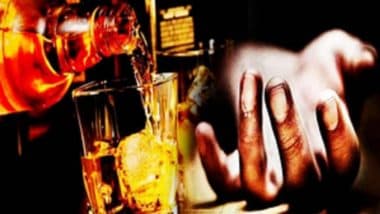New Delhi, June 27: Sales of Indian-made foreign liquor (IMFL) rose by 14 per cent in volume terms to 385 million cases in FY 2022-23 while premium products priced over Rs 1,000 per 750ml bottle grew by 48 per cent, according to industry body CIABC.
Sales are almost 12 per cent higher than the pre-Covid levels of FY 2019-20, indicating that the impact of Covid has fully worn off, it said. The industry is expected to grow in the current fiscal by 8 per cent to end around 412-415 million cases (9 litres each), the report by the Confederation of Indian Alcoholic Beverage Companies (CIABC) stated. Liquor Sale: Kerala Records All-Time High Alcohol Sales Worth Rs 624 Crore Ahead of Onam.
In FY23, whisky remained the largest segment with an expected sales volume of 243 million cases, contributing 63 per cent of sales of the total industry. Moreover, after many years of decline, Gin seems to have reversed the trend and is back in growth, added the report CIABC, which is the apex body of the Indian Alcoholic Beverage Industry. Liquor Sales in Telangana: KCR Govt Aims to Earn Rs 375 Crore in Revenue From Alcohol Business Amid COVID-19 Lockdown.
According to the report, the trend of premiumisation has continued in the liquor industry as tumblers prefer for high priced offerings. "Higher price segments are growing much faster than the lower segments and the share of brands above Rs 500 per 750ml bottle is now at 20 per cent," it said, adding the price segment of Rs 1000 and above is dominated by imported products and reported 48 per cent growth.
The market is still dominated by low-priced products, selling below Rs 500 per 750ml bottle accounting for 79 per cent of the total sales. While segments priced between Rs 500 to Rs 1,000 accounted for 21 per cent of total sales and above Rs 1,000 (mostly imported) contributed 3 per cent of the sales.
However, the share of Indian products in Rs 1,000 and above has risen from 18 per cent to 20 per cent in FY23, indicating a faster growth for Indian products in this segment compared to imported products, it said.
CIABC Director General Vinod Giri said: "Liquor industry has sailed through the adverse impact of the Corona pandemic on sales. After a slowdown for couple of years, we are again on fast sales growth path.” Region wise, the CIABC report said barring a few states, growth has been fairly 'consistent' across India.
"It has grown by 32 per cent in Western region, 22 per cent in Eastern region, 16 per cent in Northern region and 9 per cent in the Southern region," it said. Like earlier, the Southern region has remained the largest contributor to sales volume with 58 per cent share followed by West and East, which contributed 22 per cent equally.
The North region contributed 16 per cent of the total sales, as states likes Punjab has a whopping 54 per cent growth over last year. "This appears that the new excise policy has had a very positive effect in a state where IMFL segment has historically been very sluggish and smaller compared to even neighbouring states including Himachal and Uttarakhand," it said.
While, Delhi, despite disruption from the excise policy changes and the non-availability of many brands, maintained a healthy annual growth rate of 36 per cent YoY.
"However, a closer analysis shows that much of this growth is attributed to the First quarter of 2022-23 when various trade schemes and promotions were run to liquidate the stock in view of the impending changes in the excise policy. Thereafter sales growth has been trending down reaching negative range," it said.
However, some states reported a decline in sales also such as Telangana (-6 per cent), UP (-1 per cent) and Uttarakhand (-3 per cent). Over the outlook, CIABC said it expects sales in Telangana and Uttarakhand to recover and other states to maintain growth momentum.
"Following the likely Growth Momentum, we expect the liquor industry to end the year FY 23-24 to end around 412-415 million cases which would be a growth of 7-8 per cent," it said. CIABC said it may see challenges in UP, West Bengal and Delhi unless appropriate regulatory interventions are made in these states.













 Quickly
Quickly





















